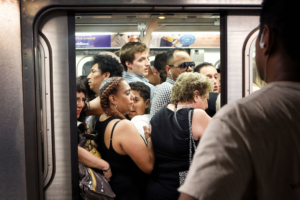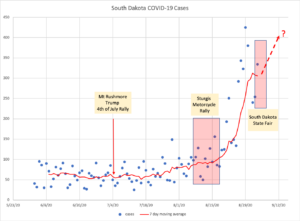(Seattle-Day 16) The COVID-19 Response Team, a group of top researchers at Imperial College-London just released a paper that stopped me in my tracks. It considers the end game for the pandemic described in my March 14 post and fills in the blanks. How long will this last? How many people will die? The results are so disturbing I honestly hesitate to post them.
The paper starts with this premise:
“Two fundamental strategies are possible: (a) mitigation, which focuses on slowing but not necessarily stopping epidemic spread – reducing peak healthcare demand while protecting those most at risk of severe disease from infection, and (b) suppression, which aims to reverse epidemic growth, reducing case numbers to low levels and maintaining that situation indefinitely.”
The Reproduction number, R0, which is the average number of new infections caused by each infected person (see my earlier post for more details). This paper defines suppression as the interventions necessary to reduce R0 to 1 or below, the point at which stopping or reversing the epidemic becomes possible, at least temporarily.
The researchers developed computer models to predict the course of the epidemic under various scenarios. The public health interventions they considered were:
- Case Isolation in the home: this is the classic quarantine for infected people not needing hospitalization, a minimal intervention,
- Voluntary home quarantine of contacts: isolating exposed individuals.
- Social distancing of those over 70: protecting the most vulnerable.
- Social distancing of entire population: as we are now doing in Seattle and other areas with high rates of disease.
- Closure of schools and universities.
The simulation found that suppression required a combination of case isolation, social distancing of the entire population, household quarantine or school and university closure. This is what is happening in Seattle as well as many of the hard-hit areas of the country such as California, New York, and Michigan. The study concluded that suppression, as they define it would require these measures to remain in place for at least 5 months. School and university closure is predicted to be more effective in achieving suppression than household quarantine.
In other words, the extreme methods taken here in Seattle and elsewhere might become the new normal as we hunker down and wait for a vaccine. The authors did conclude that limiting social gathering size was probably NOT a particularly effective intervention strategy because of the relatively short duration of the event (as compared to time in school, time at home, and time at work).
This state-of-the-art study, by top researchers concludes with an estimate that one million people will die in the United States over the next 12-18 months as we wait for a vaccine with suppression. That number would rise to two million if we limit ourselves to mitigation through conventional quarantine methods.
Before we panic, remember that this is a computer model, so the output is driven entirely by the assumptions that underlie it. All of the assumptions are based on limited data and could be flawed. Some specific possible limitations include.
- Case-fatality rates were largely drawn from Chinese data. Korea had much lower rates than China by about 50%, so it is possible that true case fatality is lower than the one used in the model which would mean that the model is overestimating deaths.
- It is not clear that immunity conveyed by infection was considered in the model. If not, infection rates would be overestimated.
- Most of the models for R0 were based on densely populated areas. R0 might be lower in rural areas.
In many ways, the process employed and the questions addressed are far more important than the numerical conclusions of the model. Up to this point we have been reactive and somewhat rudderless in responding to this crisis. This paper represents the kind of analysis responsible government agencies at all levels, from national, to state, to local, should be doing in response to this outbreak. By testing and improving the model and modifying assumptions as more data become available, this sort of model can provide decision makers with key information to make informed decisions and test out new policies.


